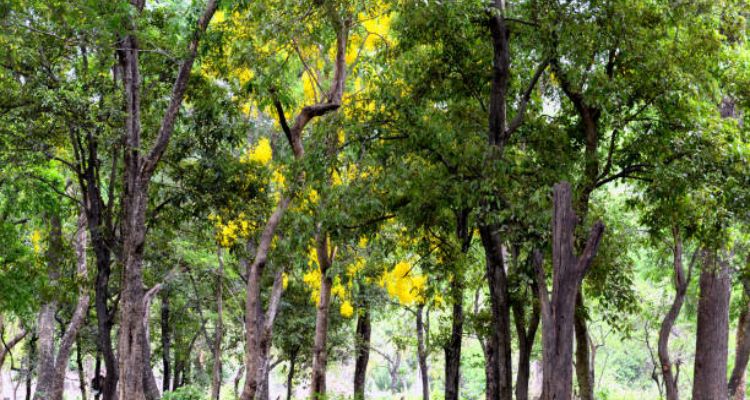|
Getting your Trinity Audio player ready...
|
The sandalwood tree (Santalum album) is an emblem of natural beauty and cultural significance, offering a multitude of benefits to humanity and ecosystems alike. In this blog, we delve into the diverse characteristics, uses, and fascinating facts surrounding this revered species. From its aromatic allure to its ecological importance, the sandalwood tree embodies a rich tapestry of attributes that have captivated civilizations for centuries.
Sandalwood Tree Scientific Classification
| Kingdom | Plantae |
|---|---|
| Division | Magnoliophyta |
| Class | Magnoliopsida |
| Order | Santalales |
| Family | Santalaceae |
| Genus | Santalum |
| Species | album |
Sandalwood Tree Characteristics
The sandalwood tree (Santalum album) possesses a distinct set of characteristics that contribute to its significance and allure:
- Appearance: Typically standing between 10 to 12 meters tall, the sandalwood tree is an evergreen with a pyramidal crown, comprising dense branches adorned with leathery, dark green leaves. Its rough, grayish-brown bark adds to its rugged beauty.
- Aroma: Among its most renowned features is the aromatic heartwood, which emanates a rich, sweet fragrance with creamy undertones when mature. This scent is highly prized and forms the basis of the tree’s commercial value.
- Habitat: Indigenous to the Indian subcontinent, the sandalwood tree thrives in diverse habitats, including dry forests, scrublands, and tropical regions. It also grows in parts of Australia, Indonesia, and the Pacific Islands.
- Lifecycle: The sandalwood tree follows a relatively slow growth pattern, taking approximately 15 to 20 years to reach maturity and develop the prized heartwood. Sustainable cultivation practices are crucial to ensure a steady supply while conserving natural resources.
- Cultural Significance: Revered for millennia, the sandalwood tree holds immense cultural and religious importance in various societies. It is used in rituals, ceremonies, and traditional medicine, symbolizing purity, spirituality, and prosperity.
- Economic Value: Beyond its cultural and spiritual roles, sandalwood is a valuable commodity in the global market, particularly in the fragrance and cosmetic industries, where its oil is used in perfumes, skincare products, and incense.
The sandalwood tree’s characteristics encapsulate its multifaceted nature, blending natural beauty, aromatic allure, cultural reverence, and economic importance.
Sandalwood Tree Uses

The sandalwood tree (Santalum album) is renowned for its diverse range of uses, spanning cultural, medicinal, and commercial domains:
- Fragrance Industry: The heartwood of the sandalwood tree is highly prized for its rich, sweet, woody aroma. It is distilled to extract sandalwood oil, a key ingredient in perfumes, colognes, and other fragrant products. Sandalwood’s unique scent lends depth and sophistication to countless fragrance compositions.
- Traditional Medicine: Sandalwood has been used for centuries in various traditional medicinal systems, including Ayurveda, Traditional Chinese Medicine, and Indigenous healing practices. Its oil and wood extracts are valued for their anti-inflammatory, antiseptic, and soothing properties, used to treat skin conditions, respiratory issues, and emotional imbalances.
- Religious and Spiritual Practices: Sandalwood holds sacred significance in many cultures and religions. It is used in rituals, ceremonies, and offerings, symbolizing purity, spirituality, and divine presence. Sandalwood incense is burned in temples, churches, mosques, and homes worldwide to create a sacred atmosphere and aid in meditation and prayer.
- Woodcraft and Artistry: The dense, fine-grained wood of the sandalwood tree is highly prized for carving, woodworking, and artisanal crafts. It is used to create intricate sculptures, religious artifacts, furniture, and decorative items appreciated for their beauty and cultural significance.
- Aromatherapy and Wellness: Sandalwood oil is popular in aromatherapy for its calming, grounding, and stress-relieving properties. It is used in massage oils, diffusers, and candles to promote relaxation, enhance mood, and alleviate anxiety and tension.
- Environmental Conservation: Sustainable management of sandalwood forests is essential for preserving this valuable resource and supporting biodiversity conservation and ecosystem health.
The sandalwood tree’s uses are multifaceted, ranging from luxurious perfumery to spiritual practices and holistic healing, underscoring its enduring cultural, commercial, and ecological importance.
Sandalwood Tree Leaves

Sandalwood tree leaves, while often overshadowed by the prized heartwood, hold their own significance and usefulness in various aspects:
- Botanical Characteristics: The leaves of the sandalwood tree (Santalum album) are leathery in texture, oval-shaped, and arranged alternately along the branches. They typically have a dark green coloration, contributing to the tree’s lush appearance.
- Ecological Role: Like other leaves, those of the sandalwood tree play a crucial role in photosynthesis, converting sunlight into energy for the tree’s growth and survival. They also contribute to nutrient cycling and soil health as they decompose.
- Cultural and Ritualistic Significance: In some cultures, sandalwood leaves are used in religious ceremonies and rituals, symbolizing purity, sanctity, and prosperity. They may be used as offerings or decorations during festivals and auspicious occasions.
- Medicinal Uses: While not as extensively studied as the heartwood, sandalwood leaves also contain compounds with potential medicinal properties. In traditional medicine systems like Ayurveda, these leaves are sometimes utilized in herbal preparations for their purported therapeutic benefits, including anti-inflammatory and antimicrobial properties.
- Potential Applications: Research into the bioactive compounds present in sandalwood leaves continues, hinting at potential future applications in pharmaceuticals, herbal supplements, and natural skincare products.
While sandalwood leaves may not garner as much attention as the tree’s prized heartwood, they play integral roles in ecology, culture, and potentially in medicine, highlighting the multifaceted nature of this revered tree species.
Sandalwood Tree Benefits

The sandalwood tree (Santalum album) offers a plethora of benefits, ranging from cultural and spiritual significance to practical and economic advantages:
- Aromatic Qualities: Perhaps its most renowned benefit lies in its aromatic heartwood, which emits a rich, sweet fragrance with creamy undertones. This aroma serves as the basis for its extensive use in perfumery, cosmetics, and incense.
- Medicinal Properties: Sandalwood possesses various medicinal properties, making it a valuable ingredient in traditional healing practices. Its oil is prized for its anti-inflammatory, antiseptic, and soothing effects, used to treat skin conditions, respiratory issues, and emotional imbalances.
- Spiritual and Cultural Significance: Revered for centuries in various cultures and religions, sandalwood holds sacred importance in rituals, ceremonies, and spiritual practices. It symbolizes purity, spirituality, and divine presence, fostering a sense of connection and reverence.
- Woodcraft and Artistry: The dense, fine-grained wood of the sandalwood tree is highly prized for its aesthetic and practical qualities. It is used in woodworking, carving, and artisanal crafts to create intricate sculptures, religious artifacts, furniture, and decorative items appreciated for their beauty and cultural significance.
- Economic Value: Sandalwood contributes significantly to the global economy, particularly in regions where it is cultivated and harvested. It supports livelihoods through its role in industries such as perfumery, cosmetics, pharmaceuticals, and handicrafts.
The sandalwood tree’s benefits extend beyond its aromatic allure, encompassing medicinal, cultural, economic, and artisanal dimensions, underscoring its multifaceted importance in various aspects of human life and society.
Sandalwood Tree Facts

Sandalwood trees (Santalum album) are fascinating plants with a rich history and unique characteristics:
- Slow Growth: Sandalwood trees have a relatively slow growth rate, taking around 15 to 20 years to mature and develop the highly prized heartwood.
- Aromatic Heartwood: The heartwood of the sandalwood tree is renowned for its rich fragrance, characterized by sweet, woody notes with creamy undertones. This aroma is highly valued in perfumery, cosmetics, and incense production.
- Cultural and Religious Significance: Sandalwood holds significant cultural and religious importance in many societies. It is used in rituals, ceremonies, and spiritual practices, symbolizing purity, spirituality, and divinity.
- Native Habitat: Indigenous to the Indian subcontinent, sandalwood trees thrive in diverse habitats, including dry forests, scrublands, and tropical regions. They are also found in parts of Australia, Indonesia, and Pacific Islands.
- Semi-Parasitic Nature: Sandalwood trees exhibit a semi-parasitic growth habit, relying on host plants for some of their nutrients. This unique adaptation contributes to their ecological role and habitat requirements.
- Commercial Value: Sandalwood is a valuable commodity in the global market, particularly for its heartwood, which is used in perfumery, cosmetics, traditional medicine, and woodcraft. Sustainable management practices are crucial to ensure its conservation and responsible exploitation.
Sandalwood trees are not only valued for their aromatic wood but also for their cultural, ecological, and economic significance, making them an integral part of many societies and ecosystems around the world.
Sandalwood Tree Lifespan

The lifespan of a sandalwood tree (Santalum album) can vary depending on various factors such as environmental conditions, management practices, and genetic factors. Generally, sandalwood trees have a relatively long lifespan compared to many other tree species.
In their natural habitat, where they receive adequate sunlight, water, and nutrients, sandalwood trees can live for several decades to over a century. With proper care and management, some specimens have been known to survive for up to 80 to 100 years or even longer.
However, the lifespan of sandalwood trees can be influenced by factors such as disease, pests, habitat destruction, and overharvesting. In regions where sandalwood is cultivated for commercial purposes, trees are often harvested before reaching their full potential lifespan, typically around 15 to 20 years of age when the heartwood has developed.
Sandalwood trees also exhibit a unique growth pattern, with a relatively slow growth rate in the early years, followed by a period of more rapid growth as they mature. Sustainable management practices are essential to ensure the longevity of sandalwood trees and to maintain healthy populations for future generations to enjoy their cultural, ecological, and economic benefits.
How to Grow Sandalwood Tree
Growing sandalwood trees (Santalum album) requires careful planning, attention to detail, and patience due to their specific requirements and slow growth rate. Here’s a comprehensive guide on how to grow sandalwood trees:
- Selecting the Site: Choose a well-drained location with sandy or loamy soil and ample sunlight. Sandalwood trees prefer warm climates with temperatures between 20°C to 30°C (68°F to 86°F). Steer clear of regions susceptible to waterlogging or frost.
- Preparation of Seedbed: Prepare a seedbed by tilling the soil to a depth of about 30 centimeters (12 inches) and removing any weeds or debris. Ensure proper drainage to prevent waterlogging.
- Seed Selection and Treatment: Obtain high-quality sandalwood seeds from a reliable source. Treat the seeds with a fungicide to prevent fungal infections and soak them in water for 24 hours before planting to enhance germination.
- Planting: Plant the treated seeds in rows with a spacing of about 2 to 3 meters (6.5 to 10 feet) between each seed. Sow the seeds at a depth of 1 to 2 centimeters (0.4 to 0.8 inches) and cover them with soil. Water the seeds gently after planting.
- Watering and Irrigation: Provide regular watering to keep the soil moist but not waterlogged. During the establishment phase, young seedlings require consistent moisture to encourage healthy growth.
- Weed Control: Keep the area around the seedlings free from weeds, which can compete for nutrients and water. Mulching with organic materials can help suppress weeds and retain soil moisture.
- Nutrient Management: Monitor the nutrient levels in the soil and provide appropriate fertilization if necessary. Sandalwood trees have relatively low nutrient requirements but may benefit from occasional applications of balanced fertilizers.
- Pruning and Thinning: As the seedlings grow, thin out weaker or overcrowded plants to promote vigorous growth and airflow. Trimming any deceased or infected branches is essential for preserving the overall health of the tree.
- Pest and Disease Management: Monitor the trees regularly for signs of pests or diseases and take appropriate measures to control them. Common pests include scale insects and root rot, which can be managed through cultural practices and the application of insecticides or fungicides if necessary.
- Patience and Long-Term Care: Sandalwood trees have a slow growth rate and typically take 15 to 20 years to mature and develop heartwood. Exercise patience and provide consistent care to ensure the trees reach their full potential.
By following these steps and providing proper care and management, you can successfully grow sandalwood trees and enjoy their aromatic wood and various benefits for years to come.
5 Types of Sandalwood Tree

There are several species of sandalwood trees, each with its unique characteristics and distribution:
- Santalum album (Indian Sandalwood): This is the most well-known and commercially important species of sandalwood. Native to the Indian subcontinent, it’s prized for its aromatic heartwood, which is used in perfumery, incense, and traditional medicine.
- Santalum spicatum (Australian Sandalwood): Found primarily in Australia, this species also produces aromatic heartwood with similar properties to Indian sandalwood. It’s utilized in perfumery, cosmetics, and pharmaceuticals.
- Santalum ellipticum (Hawaiian Sandalwood): Endemic to Hawaii, this species is valued for its aromatic wood and cultural significance. It has been historically used by Native Hawaiians for various purposes, including ceremonial and medicinal uses.
- Santalum paniculatum (Pacific Sandalwood): Found in various Pacific Islands, including Fiji and Vanuatu, this species also produces fragrant heartwood. It’s utilized locally for its aromatic properties and cultural significance.
- Santalum austrocaledonicum (New Caledonian Sandalwood): Endemic to New Caledonia, this species is highly valued for its aromatic wood and has been heavily exploited. Initiatives are in progress to safeguard existing populations through conservation measures.
These are just a few examples of sandalwood tree species, each with its own geographical range, growth habits, and uses. While Indian sandalwood (Santalum album) remains the most widely known and economically important species, other varieties also contribute to the cultural, commercial, and ecological landscape in their respective regions.
Wrapping Up
The sandalwood tree stands as a testament to the intricate relationship between nature and human culture. Its multifaceted characteristics, ranging from its aromatic heartwood to its ecological role, underscore its enduring significance. As we continue to explore and appreciate the myriad uses and benefits of the sandalwood tree, let us also strive to ensure its conservation and sustainable management for future generations to cherish and enjoy. Whether in perfumes, traditional medicine, or spiritual practices, the sandalwood tree continues to leave an indelible mark on our lives, reminding us of the profound connections that bind us to the natural world.
Don’t Miss: Succulent Plant | Care, Types, Benefits and Décor Ideas



